With the repair of the bathroom, as a rule, there are many problems. You ask, like so, because the room is small, so the repair should be facilitated? In this case, it should be noted that the bathroom is among the so-called "whimsical". Therefore, in order to provide a certain complex of repair and finishing works, it will be necessary to perform a lot of additional work.
It is also very important and difficult to choose the necessary finishing materials for the bathroom, which fully meet the requirements of work in conditions of high humidity levels. After all, these characteristics are not answered by every coating, and this means that even before the beginning of repairs, it is necessary to understand the intricacies of repair in bathrooms.
Bathroom finishes
Repair of the bathroom can be done with various materials designed for use in harsh environments. Their choice is very large, and the most popular of them are:
- drywall;
- wall panels;
- mosaic material;
- self-adhesive film;
- ceramic tile;
- paint and wallpaper.
Ceramic tile
Ceramic tile refers to the special kind of products for the production of which mainly clay is used. The very surface of this product is covered with a layer of enamel. Just it is the main barrier to confront high humidity. Ceramic tiles possess high refractoriness, have excellent hygiene and are quickly and easily cleaned of impurities. And while it does not have a radiation background.

Professional builders and "advanced" townsfolk in one voice argue that only ceramic tiles are the ideal material for finishing the surface of walls in the bathroom. Installation of tiles on the walls requires certain skills and knowledge, so it can not be performed by every ordinary person in a professional manner. Beginning directly facing the tiling is preceded by a large and labor-intensive preparatory work, although it does not require the thoroughness that is necessary for preparing the walls for painting.
This means that roughing the surfaces to be tiled can be done sparingly. For example, old paint does not need to be completely scraped. You can also do without the necessary incisions on the wall surface. It will be enough to remove the doubt-causing coating, rinse the surface with a soap solution and plaster the exposed places, after which the entire surface should be thoroughly primed with PVA glue (dilute it with a one-to-two ratio, glue / water). Priming mixture should be applied also in the event that the old whitewash or paint is removed from the surface of the walls.
So, the walls are primed, now for the continuation of the work should be done marking the walls, which will quickly allow you to mount the tiles on the landmarks. To do this, first a mark is made in the lower left corner of the wall at a height equal to the height of the used tile from the floor level, which will be the reference point for applying the marking line along the entire perimeter of the wall surface. It is very important that the marking line, having passed through the entire perimeter, is closed at the starting point. In this case, the distance from the floor level to the target line should be the same everywhere.
Mismatch indicates that the markup is not executed correctly and should be remade. Marking work should be carried out especially carefully, as they will affect the quality and entertainment after finishing the finishing works in general.
The next stage is preparation of the glutinous mixture. The glue powder must be diluted to the consistency of sour cream and applied to the prepared tile. It is better to do this with a special notched trowel. The size of the teeth of this instrument should be selected based on the depth of the wall's roughness, that is, the thinner the wall, the smaller the length of the teeth.
Laying the tiles begin with one of the corners of the wall, skipping the bottom row, and starting with the second row. The tiles of this row should be laid over the drawn marking line (for convenience, you can temporarily fix a wooden rail or metal profile) with the obligatory arrangement of the lower edge of the ceramics strictly parallel to the mark.
After the first installed tiles laid second in line with the implementation of the same requirements. In this case, leave some space between the tiles. In order for the distance between these and all subsequent tiles to be even, insert special plastic crosses of a certain thickness in the lower and upper part of the interlacing seam that define the width of the seam. For example, for tiles 25x30 centimeters, it is best to use crosses measuring 2.5 millimeters.
Also, the tile is to be leveled in two planes, for which it is best to use the building level. The third tile should be laid on top of the first, and also using crosses to ensure the dimensions of the seam. The subsequent installation of ceramic tiles is carried out in a manner similar to the described method. After each subsequent laid tile of one row, the tile is placed in the upper row above it, and then the third and subsequent rows. That is, we on the wall "build" a kind of staircase of tiles - steps that rise to the ceiling. And only after that the tiles from the steps fit to the right (opposite) part of the wall.
Mosaic
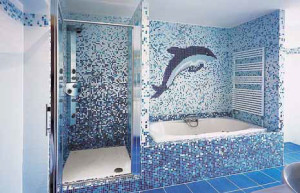
This finishing material is a product of a tiled type of a relatively small size with one or more color shades. Such an original material is made of several options - from smalt, stone, ceramic or glass.
As soon as the boom over the wall surfaces with ceramic tiles was over, most designers once again remembered the mosaic tiles. And this is not surprising, because mosaic has long been considered the most popular ornamental decoration. And it is not unreasonable, because the mosaic surpasses in many respects ceramic tile. With this material, not only smooth wall surfaces, but also rounded, inclined and other unusual surface complexities can be cut very quickly and easily.
Also at the height of the mosaic aesthetic appearance. Thanks to the mosaic tile you can collect any composition, drawing, panel, symbol, inscription, and if desired, and your own portrait.
Correct laying of mosaic tiles
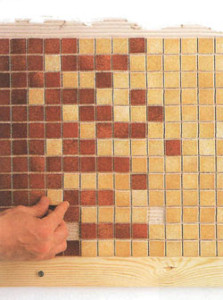
For an impeccable laying of mosaic tiles, it is not enough to have a designer flair and artistic taste. The mosaic will long and perfectly look when it is stacked by real experts. Well-known experts before finishing work, first pay sufficient attention and time for leveling the surface on which the mosaic will be located (this is done with cement mortar, which is applied to the walls with a large spatula, and the layer must be perfectly even).
Also, before the beginning of the work, you should draw a sketch of the drawing or composition, which you are going to put in mosaic tiles. For this, a schematic drawing of the arrangement of the colored elements and tones of the mosaic elements must be put on paper. Having worked the drawing, the marking can be applied to the wall. This will be a reference point for the subsequent stacking of different colors in the overall composition.
Having finished with the preparatory work, it is necessary to make the elements fit. It will be easier to do this if the future picture is placed on the dry floor. Carefully compare all the elements of the mosaic and, if necessary, trim necessary ones from them with special cutters, and this should be done with utmost care and thoroughness. After performing the adjustment, the inside of the mosaic-treated sheets is treated with a special glue.
The glutinous mixture is first distributed with an even side of the ironing tool, and then with a jagged edge of the same tool, it is wavy. Avoid the formation of an adhesive layer that is more than one centimeter thick.
Now the mosaic is applied to the wall and by tapping lightly on the entire surface of the mosaic elements, it is fixed to the intended surface. That's the way to put all the mosaic. A day after installation works you can remove the paper from the elements of a firmly fixed mosaic composition. Simplify the removal of paper foam rubber sponge, with which a glossy coating is abundantly moistened with water and then the soaked paper can easily be removed from the surface of the mosaic.
At the final stage of the mosaic design, joints are sealed with an epoxy grout. It is resistant to aggressive media and moisture-resistant material. Grout is applied lightly with a rubber spatula of small size. The part of the mixture that fell on the front surface is removed with a wet sponge.
Use the bathroom for its intended purpose can be only after thirty days, this time is necessary to ensure complete drying of the mosaic finish.
Drywall
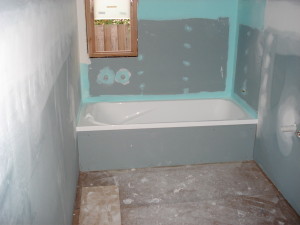
This is a composite material of sheet design. The basis of this product is gypsum, coated on both sides with a layer of cardboard. It is recommended that the wall surfaces of the bathroom are made of plasterboard sheets with high resistance to high humidity. Wall decoration with moisture resistant gypsum board can be done very quickly with the help of certain experience and knowledge. Given the fragility of the material, work on its preparation, installation and fitting should be done extremely accurately.
To finish the walls of the bathroom with plasterboard it is required to prepare such materials and tools:
- moisture resistant gypsum board;
- water-based paint;
- sandpaper;
- edge planer;
- sharp knife;
- electric drill;
- a hacksaw for wood and metal;
- a hammer;
- screwdriver;
- roulette;
- building level;
- ruler;
- metallic profile;
- fastening elements.
Prior to the beginning of the work with plasterboard, the walls should be leveled. This means that all protrusions, cracks, depressions, scratches and other possible defects on the surface of the walls must be eliminated. After that, a working frame for fixing gypsum boards is mounted on the wall. For these purposes, the metal profile that is placed on the surface by horizontal lines is best suited. To securely fasten the drywall, several rows of the used metal profile should be created, then between the resulting lines fix the posts with a distance between them of 60 centimeters. The result should be a metal crate.
And only now we start to work with plasterboard. We start with cutting the material, that is, we cut out the right size fragments, which we attach to the crate with the help of screws. The hats and heads of the fastening elements must be drowned in the finishing material. At the end of the construction of the skin, dirt and dust are carefully removed from it, after which a priming liquid is applied to the gypsum board.
If you want to achieve a perfectly flat surface, plasterboard lining should be completely ground.
At first, with the putty material, the places of tightening of the screws, joints and corners are closed. Then the mixture covers the entire surface of the skin. After leveling, the putty is peeled with fine-grained sandpaper. Having made sure of the required smoothness and smoothness of the surface, the drywall is covered water-based paint. Qualitative execution of the work involves coating the surface with three layers of colorant.
Wall panels
Panels of this design today are considered one of the most popular facing materials. Finishing the bathroom is best done with products made from PVC. Panels from this material are very quickly mounted, do not require special care and very slightly weight the wall. Using plastic panels for facing, you effortlessly level the walls of any curvature.
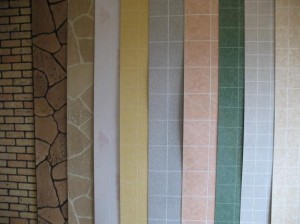
If the walls of the bathroom have a flat surface, the panels can be mounted directly on the base of the wall without the construction of a working frame. It is enough to clean the work surface of dust and dirt. After that, immediately fill in all the cracks, notches and chips and carefully cover with priming liquid. If there are enameled or varnished elements on the surface, they must be sanded with sandpaper.
Now it's the glue line. Glutinous mixture should be applied to the wall as evenly as possible and give it some time to get it clamped. Having convinced that the technological process is sustained, it is possible to start gluing the panels. Plastic strip ahead of the prepared size is applied to the adhesive layer and immediately smoothed from the center to the sides of the strip with a direction from top to bottom. After making sure that the panel has grasped sufficiently and is held on the wall, the next plastic strip is placed. Methods for overlaying panels depend on the type of product. In some cases, the manufacturer provides for mounting by the method of joining strips, in others - overlap (the latter method of installing PVC panels is currently used quite rarely).
If there are significant nervousness and swings on the wall, a working skeleton should be made on the surface of the wall. For its device use a metal profile or wooden bars, impregnated with antiseptic, preventing decay of wood. Beams or profiles should be mounted on the surface strictly perpendicular to the direction of the panels. Between wooden blocks should maintain a distance of 60 centimeters.
Installation of panels on the glue or working frame is carried out from the inside or outside corner of the bathroom.
To fix the material to the frame, special fixing brackets are used. Panels should be located strictly on the same level, for which it is necessary to constantly monitor the progress of installation work by the construction level. To ensure the panels have a long service life, it is recommended to make ventilation holes in unobtrusive areas (holes must prevent water from entering). Specialists and designers believe that the most suitable for these purposes is the skin line, almost bordering on the floor level.
Adhesive tape
With a self-adhesive film, you can very quickly impart a noble appearance to an old, lost sight of the surface in the bathroom. In the building materials market, a huge selection of films of very different colors and shades, with imitation of natural wood, cork, marble and other interesting imitations. Just like with the depiction of various figures and abstract drawings.
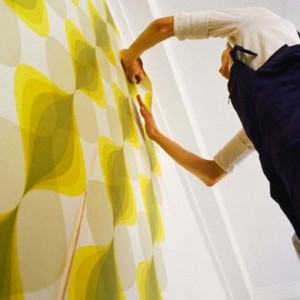
The composition of the self-adhesive film guarantees a secure attachment to the wall. Another undoubted advantage of the film is its cheapness. At least, finishing the bathroom with ceramic tiles will be much more expensive. And if you like bathrooms with tiled walls, but you do not have the means to repair the room at this stage of the renovation, you can buy a self-adhesive film with imitation of ceramic tiles. Also, how can you choose a film that reflects the surface of metal, stone, leather, gold, silver, holographic or mirror image.
Of course, the operating life of the film is much less than the mentioned ceramic tile. But when deciding to refresh the interior of the bathroom, the film can be dismantled and pasted with the same material with a completely new pattern. Mini-repair of this performance does not require much time and money. And if you do not want to mess with the old film, then new material can be pasted on top of it. Thus, you will refresh the podnadoevshy interior design in the shortest possible time.
Pasting of the surfaces of walls with a film is very simple. First, cut the strips of the correct size from the roll. Immediately before gluing on the inside (without drawing), carefully remove a small protective paper layer, after which part of the film released from the paper is applied to the top of the pasted wall and gradually, carefully breaking the film from the center to the sides and from the top to the bottom, we paste, simultaneously removing pieces of protective paper. As you can see, there is nothing complicated, we repeat the process of applying wallpaper to the surface. In case of improper sticking of the film, it can be removed and re-glued, although it is desirable to glue the strip in one step.
You will be fully satisfied with the result of your work if the pasted film is an ideally flat surface, and for this you must carefully prepare the pasted surface, it should not have any defects, because the presence of depressions, pimples , cracks significantly reduce the spectacular effect.
Wall decoration by wallpaper or painting
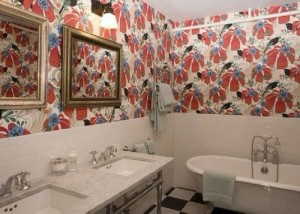
Wallpaper in the bathroom, as a rule, is a rarity. For such specific rooms with high humidity, materials with a higher degree of water resistance are usually used. The walls are glued in the bathroom using the same technology as on the surfaces of other rooms in the apartment.
Also, the finishing of the wall surfaces of the bathroom can be done with paint. This method of finishing is also not often used, because even with the use of expensive paint and varnish materials you will not achieve that luxurious appearance, as when decorating with ceramic tiles, marble, mosaic or plastic panels. Well, if you still decided to give preference to paint, then it is necessary to use special waterproof materials, for example, from the discharge of water-dispersion paint.
A natural stone

If you want to wall the bathroom walls with a stone, you first have to decide what kind of material you want to see in the bathroom. Because the finishing stone is a great choice. For example, marble, quartzite, granite or slate look good with the same success. These are interesting stone products with an unusual pattern and a peculiar texture.
The technology of wall cladding is best performed by the way of applying the material tightly to the wall. When installing the stone in this way, the first row should be laid on a special holding plinth. After that, the stones should be further cemented together with a cement or other special mortar, which will make the fastening of the finishing material strong and reliable. All subsequent rows of stone are laid on the previous ones and are also fastened together by a connecting mixture. Completing the masonry in this way, you will be guaranteed against the sliding of any of the stones from their place.
Each subsequent row is mounted only after the full consolidation of the fastening mixture of the previous row.
Finishing of the wall surface must be done without haste and with the fulfillment of all the requirements of the technological process. Only in this case you will achieve the desired result. In addition, it should be borne in mind that the thickness of the wall on which you are going to mount the stone must be at least 20 centimeters, and its bevel should not exceed one centimeter. Otherwise, the wall can not withstand the weight of the stone and under its weight simply collapses.
The result
If you want to ensure that the bathroom meets all the requirements and recommendations of today, you should competently approach the selection of finishing materials that you are going to cover its walls. In our article we have examined all the basic finishing materials most often used for facing works. Each of the described materials is inherent not only its own installation technology, but also its own characteristics relative to raw materials and performance characteristics. However, all of them are united by one indisputable property: they are high-quality finishing materials, which are characterized by reliable moisture resistance. That is, they have the indicator, which is primarily required for materials designed to work in conditions of high humidity or water - the bathroom.
Starting to repair in any of the rooms, the first thing to do is to decide on the choice of finishing material. Sometimes it is not easy, especially when it comes to such a specific room as a bathroom. If you have to finish the walls in the bathroom materials must be selected carefully, having first become acquainted with their characteristics and properties.
Requirements for the material
Variants of walls in the bathroom can be different, but that the result of the works looked aesthetically attractive, and was practical, finishing wall materials for the bathroom should meet a number of requirements:
- resistance to high humidity and frequent temperature changes;
- ecological compatibility, hygiene;
- ease of care.
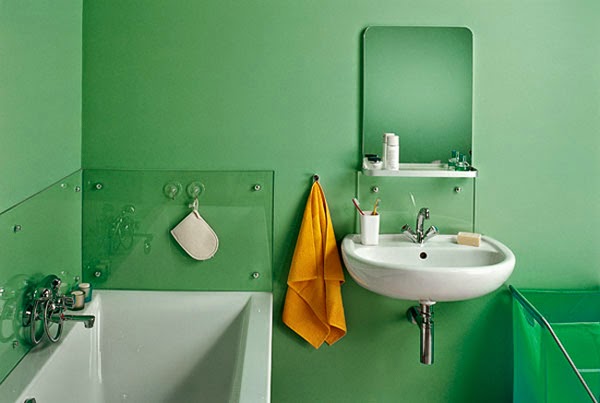
![]()
Possible options
Ways interior decoration walls in the bathroom can use a wide variety, but the most common methods:
- ceramic tile;
- mosaic;
- paint;
- wallpaper;
- pVC panels;
- drywall;
- decorative plaster.
Each of the materials has a number of advantages as well as disadvantages, which should be read before deciding what to finish the walls in the bathroom.
Ceramic tile
The most popular version of the walls in the bathroom is tiled. This is due to the many advantages of tiles, among which the main are strength, environmental friendliness, water resistance, ease of care. Thanks to a wide range of colors and all kinds of patterns, you can choose tiles absolutely for any style of decoration. As for the price of tiles, the price range is quite wide, so you can find both inexpensive options and expensive collections of foreign production.
Unfortunately, as with any material, the tile has a number of drawbacks:
- complexity, tedious installation, as well as mess, pursuing the entire work process with tiles;
- the cost of laying the tiles (it's not just about the cost of the laying itself, but also about the price of grouting, gluing and leveling compounds).
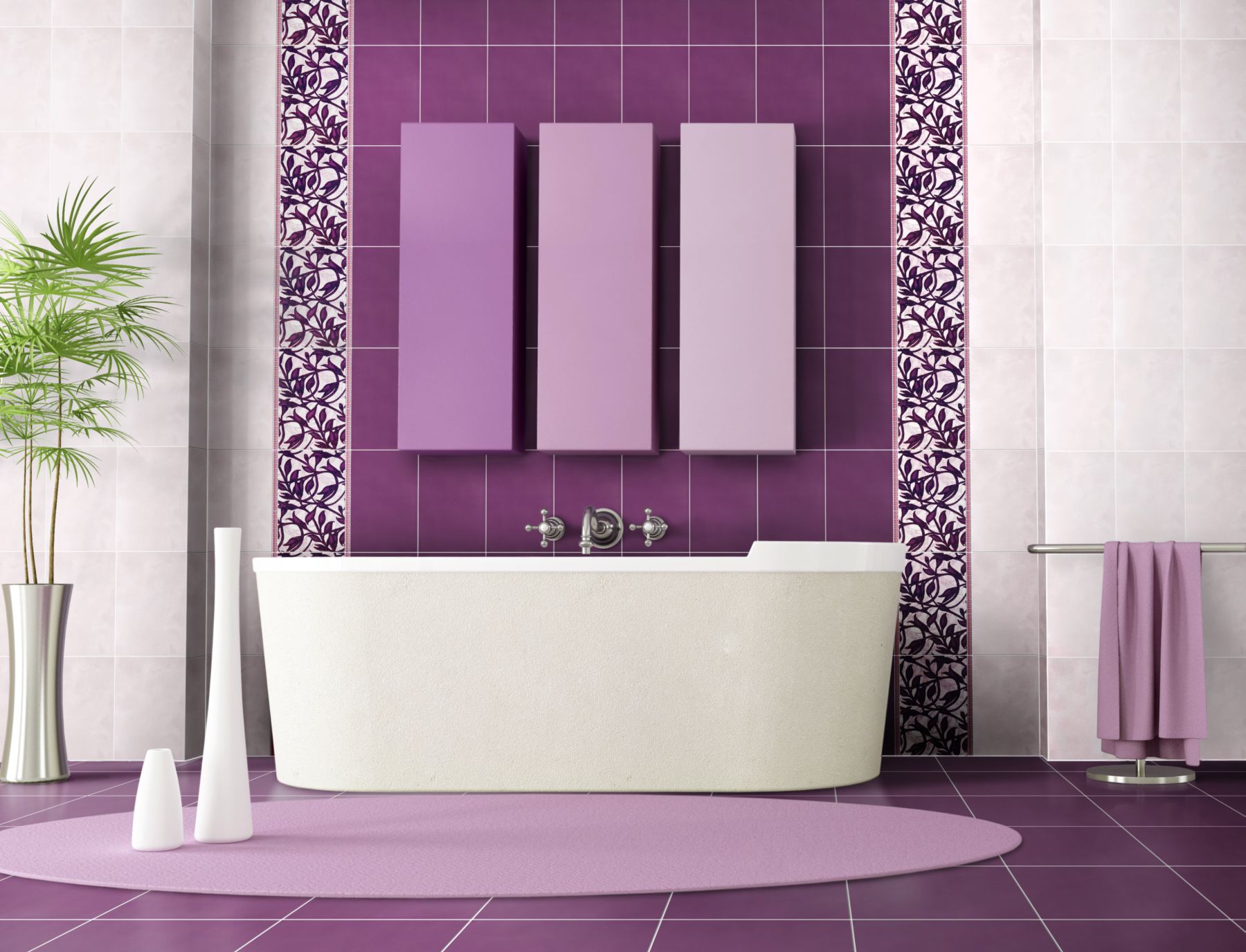

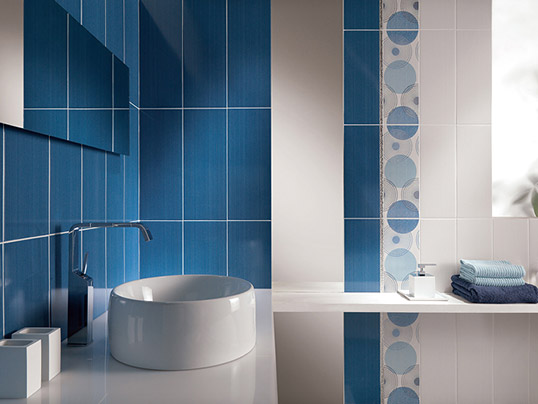
Mosaic
You can use an excellent option to make the walls of the bathroom, like a tile-mosaic. Looks materials for interior decoration is stylish, expensive, besides, caring for the mosaic is quite simple. Mosaic stands out with the advantages:
- the possibility of mounting on any surface;
- impact resistance;
- strength, reliability, durability;
- resistance to burnout.
Having listed the advantages you can not forget about the disadvantages:
- high cost, especially when it comes to mosaic made of natural stone;
- complexity of installation.
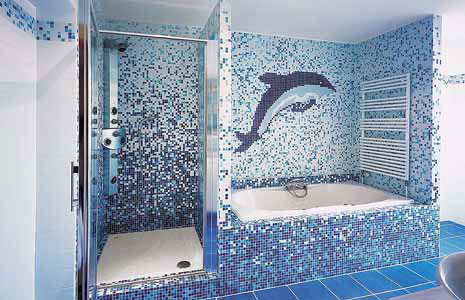
![]()

Paint
Painting walls is a relatively inexpensive option for decorating wall surfaces in the bathroom. Gone are the days when for these purposes only oil paint of green or blue color was used. The choice of paint and varnish materials is quite wide, and the paint finish allows you to realize the most daring imaginations, putting on the walls patterns and drawings. You can use stencils for such interior decoration.
The advantages of paint design are:
- economy - the type of paint finish is considered one of the most economical, given the cost of materials and work;
- large selection of colors. To date, in the building stores are presented the colors not only of different colors, but also of different textures, effects;
- ease of operation - nothing is required to apply paint other than the paint itself and the roller or brush. Any person can cope with the painting of walls, this does not require special preparation.
Among the shortcomings of the material:
- before painting, the walls need to be leveled, and this will require certain strengths and costs;
- buying a cheap material can lead to the fact that the paint on the walls quickly cracked;
- to look after the painted walls it is necessary more carefully, than behind other kinds of materials.
When choosing a paint for bathroom walls, it is best to give preference to latex, acrylic or emulsion variants, as they have such important qualities as water resistance, environmental friendliness, wear resistance, ease of application.
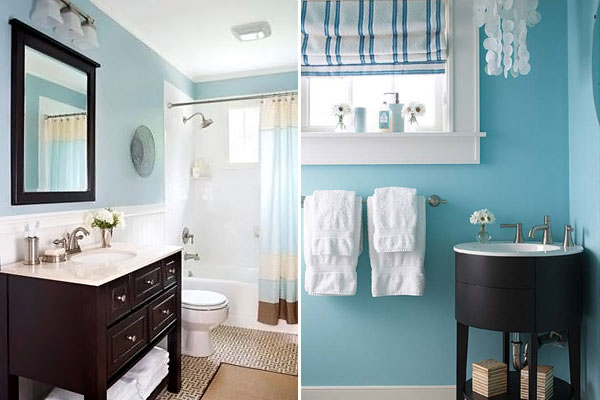
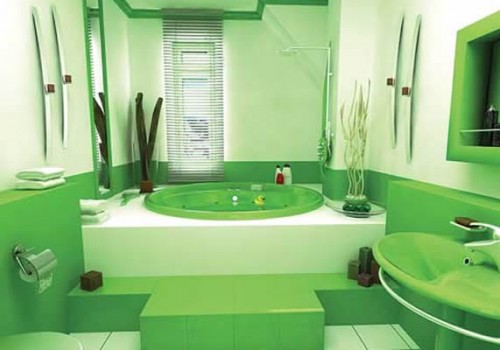
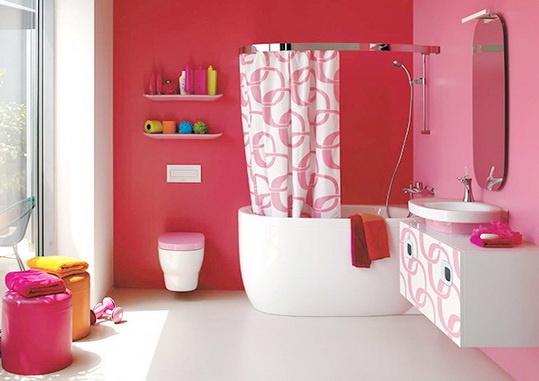
Wallpaper
Many believe that the design of wallpaper is not suitable for interior decoration of the bathroom, but in fact, this applies only to simple paper options that differ in their fragility and impatient interactions with moisture. But you can consider other options. When choosing wallpapers for interior finishing, you should pay close attention to the fact that the packaging had a symbol of resistance to moisture, which is three waves. This same requirement applies to the materials associated with the wallpaper.
Most often for a bathroom choose vinyl or acrylic variants of wall-paper which perfectly transfer a moisture, steam. The only thing that should be paid attention when decorating wallpaper is the joints, which must be well worked out so that water does not fall under them, otherwise the wallpaper will have problems.
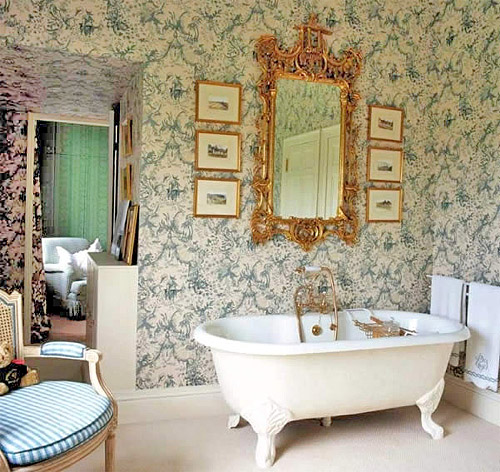
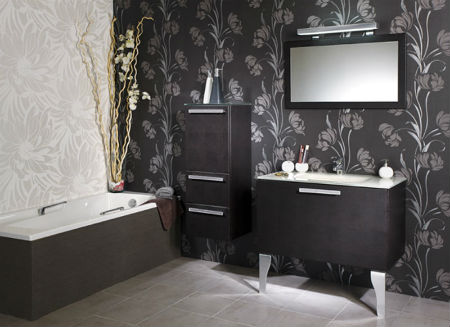

PVC Panels
One of the popular materials for decoration of walls in the bathroom are PVC wall panels, as well as all other materials possessing a number of pluses and minuses.
As for the advantages of PVC, among them:
- relative cheapness;
- light weight, easy installation and maintenance of PVC panels;
- moisture resistance;
- resistance to temperature changes, resistance to chemicals;
- wide color palette;
- no additional leveling of the walls is required before the panels are installed;
- ecological compatibility;
- durability.
Among the minuses of PVC:
- decorative - create an original pattern or pattern with plastic panels it will not be possible, for this purpose the paint or a tile will approach more. Therefore, decorative such a finish with plastic PVC panels can not be called;
- associations - many believe that if the PVC wall is used to finish many public places, then for houses, apartments, it is inappropriate and will not contribute to the creation of comfort;
- brittleness - the slightest blow or strong pressure can lead to the fact that there will be problems with the plastic panels, they will leave a dent or a crack. That's why with plastic panels you can handle only carefully.
It is often used with plastic panels for wood. These wall options look very nice, like a natural tree. Work with similar wall plastic panels is no different from working with conventional plastic panels.

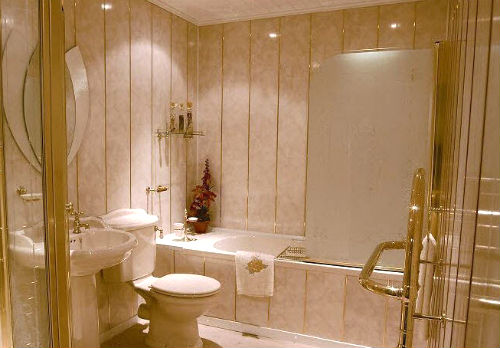
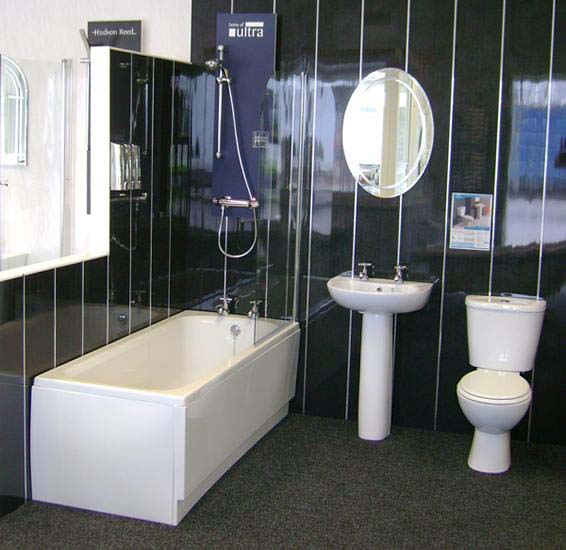
Plaster
Plaster is not only one of the preparatory stages for the installation of the finishing material on the wall surfaces, but it can also be an independent option that is suitable for use in the bathroom, especially with regard to decorative plaster. To date, not only the usual cement mixture is encountered in the construction market, but also numerous variants with additives and plasticizers, called decorative plaster.
Advantages of decorative plaster:
- quickly dries up;
- strength;
- does not give cracks;
- decorative plaster to easily hide wall defects;
- vapor permeability.
Of the minuses, it should be noted that it is best to trust such works with decorative plaster, if you want the material to last a long time and not begin to crumble in a few months.
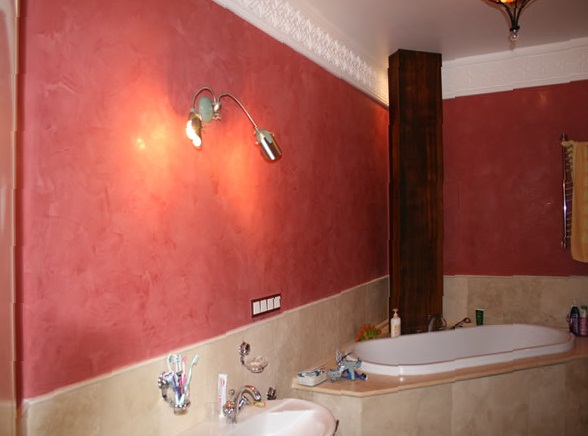
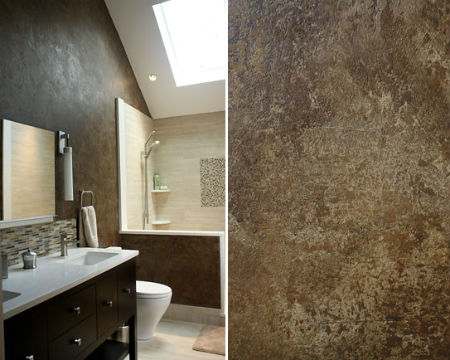
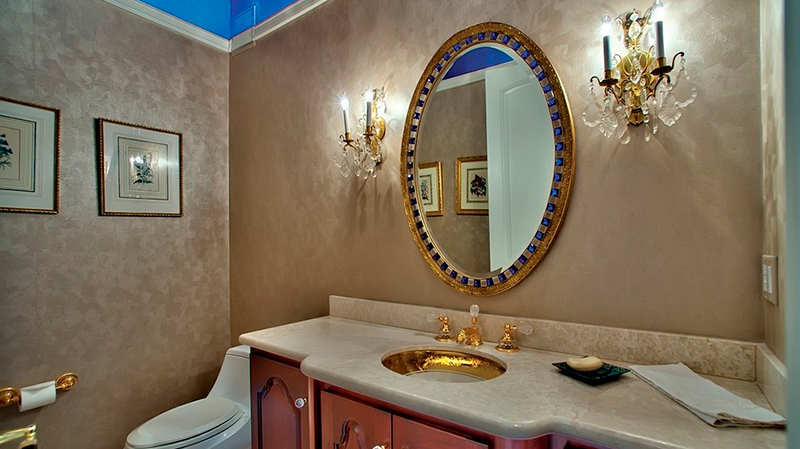
Other options
In addition to the listed materials, others can be used, which although not so popular, but also appropriate for the design of bathrooms:
- gypsum board - having decided to use gypsum cardboard for finishing the walls, remember that the material must be moisture resistant, because the usual drywall will fall apart after a while from moisture. Moisture-resistant version, thanks to a special coating, is in excellent contact with moisture and steam. The material itself is difficult to call finishing, most often it is used for leveling surfaces, and it is already applied to the wall decoration materials. That's only the owners of small-sized premises from this option will have to refuse the finish, as the plasterboard is famous for the fact that it "steals" several extra centimeters of usable space during installation;
- wood - despite the high cost of wood is a fairly popular option for finishing bathrooms. It is important to remember that not all tree species, but only oak, elm and ash are suitable for these purposes. Regardless of what type of wood will be chosen, it must necessarily be covered with antifungal composition;
- agglomerate - this material is relatively new on the market building materials. In appearance, the agglomerate resembles a tile, but it is much easier to lay it down. The disadvantages are high cost and artificial components of the material;
- mirror tiles - this unusual finishing material will allow you to visually enlarge the room, besides it is easy to install. Among the shortcomings: troublesome care, high cost and instability to mechanical influences. As a finishing material for the entire bathroom, the mirror tile is rarely used, most often it is tried to combine it with another type of finishing material by decorating the wall surfaces.
Now you know how to trim the walls in the bathroom, to eventually get a practical, aesthetic design that will please you for many years. So think carefully about how you trim the walls in the bathroom - decorative plaster, plastic panels or use other wall options, except those that do not meet the requirements.
The issue of finishing the walls in the bathroom, always relevant. If everything is not so difficult with other premises within the home, the bathroom requires a special approach - one must be able to combine aestheticism, beauty, hygiene and durability of the selected materials in such a way that all this looks holistically and naturally. Even after giving up the most original and expensive ways, choose what is not so easy - there are several options, and each of them certainly has its own advantages. Let's try to understand what the positive qualities of common design solutions are.
Immediately outline the range of materials studied. It will not go about all the aristocratic delights that are available only to the wealthiest families - the focus is only on those covers that can be found in any average bathroom. Evaluating the options for finishing the walls in the bathroom, we will start from several basic criteria, such as durability, aesthetics, complexity of installation and cost. If the evaluated variant has some special qualities, which can not be ignored, we will also dwell on them in more detail.
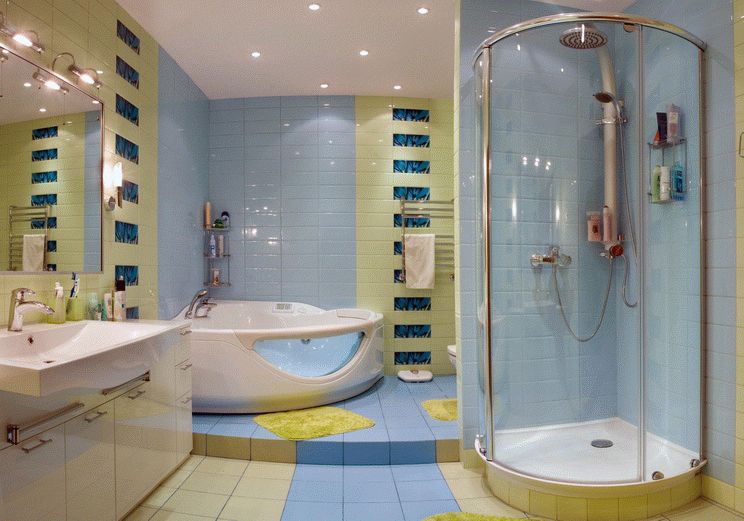
Ceramic tile
You can start with the eternal classics - ceramic tiles, used for such needs since ancient times and does not lose its relevance even in our days. Tiled walls in the bathroom are criticized by some fellow citizens for lack of originality - they say, everyone does that, but you can do something completely original, because the assortment of building stores allows you to select the most unexpected combinations.
According to the criteria proposed above, we obtain the following characteristic:
- In terms of durability, tile is an obvious leader. Even in the harsh conditions of the bathroom, this cover can last for decades, maintaining a decent appearance and functionality. If you invest in this kind of repair and do it right, then you can not think about replacing the interior for a very long time.
- Visually the tile looks fine, and most importantly - allows the owner to express themselves. The choice - the entire palette of colors and shades available to the human eye, glossy and matte solutions, not to mention the fact that all this can be combined with each other. The appearance is preserved for a long period of time, and it is almost impossible to damage the tile by improper care.
- Installation of tiles is a rather complicated procedure, so it is better to call specialists. Of course, a skilled master can try to do the work independently, but it will take a long time to tinker, and most importantly - it's hard to make sure that there are no noticeable distortions. In any case, the task is not for one day.
- Despite the fact that the ceramic tiles are included in our list of publicly available materials, it will be quite expensive to cost such repairs - it's about the material itself and about the services of the tilers.
 Decorating walls with ceramic tiles is the most practical and durable way of decorating a bathroom
Decorating walls with ceramic tiles is the most practical and durable way of decorating a bathroom Thus, ceramic tiles - this is the best option for people with good taste and a sufficient supply of money, if they want to get results for many years to come.
Paint
Deciding how, many ignore the idea of coloring, and completely in vain. Naturally, in the same way as it was done in the Soviet times, it's simply embarrassing to decorate a bathroom, but it's not about ordinary oil dyes, which are purchased at the lowest price. If you choose the coloring materials carefully, the result is able to surpass even the best expectations.
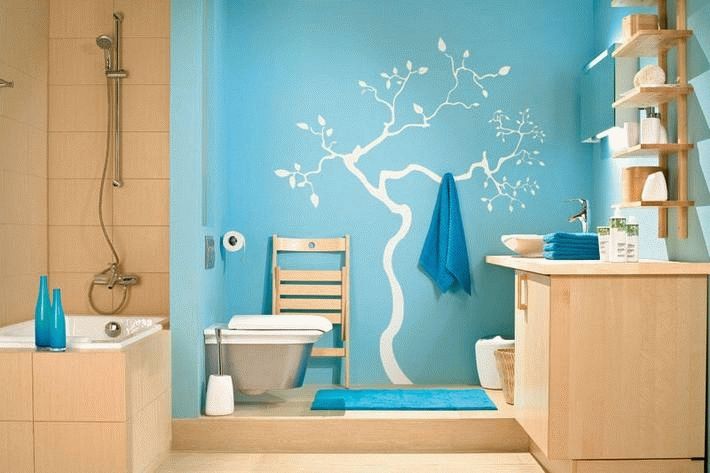
Describe the properties of a painted bathroom can be as follows:
- The period of permanent use of the coating is highly dependent on the quality of its application. With the proper observance of the procedure and the purchase of high-quality consumables, you can remove questions about repairs for several years. In a relatively short period, you can find positive - this is exactly like people who like to change the situation often.
- The aesthetics of the painted wall also strongly depends on the attitude to the matter. If you have creative abilities, you can create a real masterpiece, almost a fresco in your own bathroom, which, of course, will impress any guest. In this case, aestheticism can be seen in a simply well-colored monochrome wall.
- Actually painting is a process to which professionals are often not attracted, because roll up a wall can each. The procedure does not take too much time, and modern dyes can also dry quickly enough. Another thing is that if the wall is not perfectly level, then it will need to be prepared, by filling all the irregularities. The duration of this stage can vary significantly depending on the situation, and it is not always possible to achieve the required levelness without the help of professionals.
- At cost, coloring is clearly among the leaders - the cost of such repairs will be minimal. Those who choose paint for the sake of economy, you need to warn that it is not the economy, but the result that is important. Even if you use the most expensive paint, it will be cheaper than laying the tile, but the cheapest dye will be the top of bad taste and fragility.
Therefore, the paint can be attributed to the most affordable option with good prospects for a creative approach.
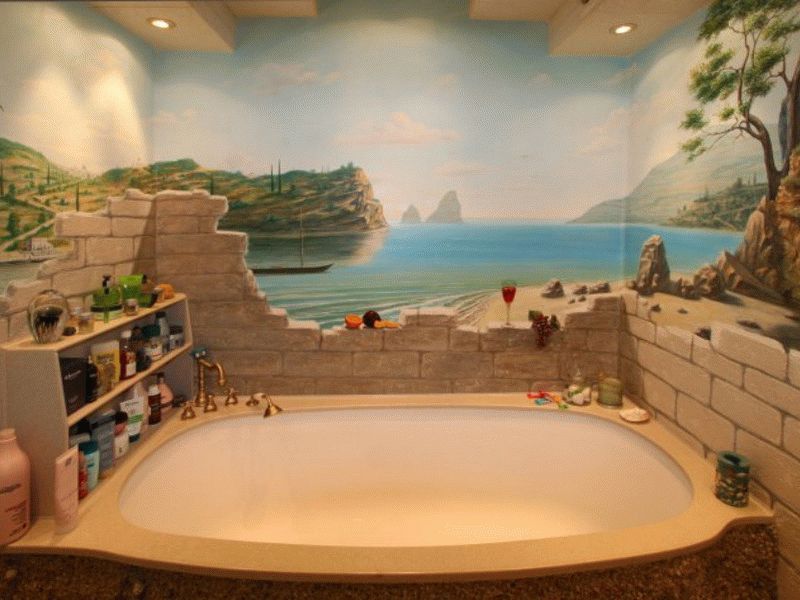 If you have creative abilities, you can inexpensively and originally design the bathroom
If you have creative abilities, you can inexpensively and originally design the bathroom Wallpaper
Do you want to stand out? Then decorating the walls in the bathroom with wallpaper - this is exactly what you need! And do not think that it is unrealizable or meaningless - today even the design of a bathroom wall-paper does not seem unreal! Judge for the advantages yourself:
- The wallpaper is relatively short-lived. To glue the bathroom recommended vinyl and acrylic varieties, which will last for several years, and paper, of course, should not even be considered. Even vinyl and acrylic have recommendations that allow them to stretch a little longer - it is desirable to glue them only if there is a closed shower cubicle, or to protect areas of close proximity to plumbing with more practical material.
- But in terms of aesthetics, this is a very chic solution! No finishing material exists in such a variety of colors, shades, patterns and images as wallpaper! For the bathroom, the actual wallpaper will be very relevant - you can place a beautiful landscape on the wall in such a way that it helps to relax.
- By the complexity of the editing of the wallpaper we refer to the middle class - you can paste them on your own, but the same photo wallpapers, where the accuracy of coincidence of segments is extremely important, it is expedient to glue the efforts of the masters. If the wall does not require additional preparation, the repair can be completed within a few hours.
- The difference in the cost of individual items of the assortment is so great that it is not necessary to talk about the price of the issue in detail. Given that paper wallpaper is not applicable, sticking will cost more than staining, everything else depends on the choice of the customer.
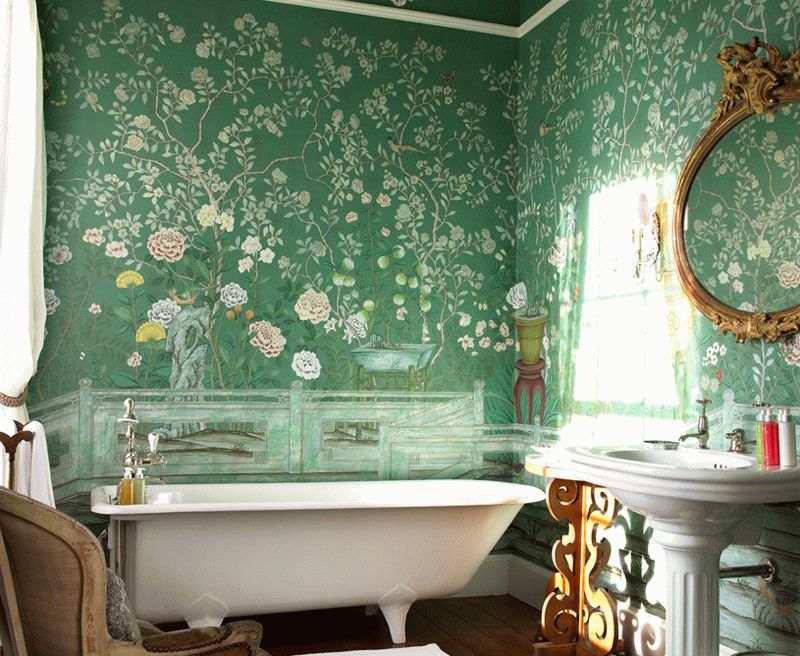 Wallpaper - not the most practical and durable material for bathroom finishing, but the variety of options allows you to create a truly unsurpassed interior
Wallpaper - not the most practical and durable material for bathroom finishing, but the variety of options allows you to create a truly unsurpassed interior Wallpaper in the bathroom - this is an indicator of originality, and often - and a high aesthetic level of the owner.
Plastic panels and waterproof plasterboard
Two different in origin materials have quite a lot of common characteristics, so we put them together. Such a solution does not yet occur very often, because it is considered to be original, and also allows to completely transform the walls of the room.
 Plastic panels - quite a popular and affordable option for finishing the bathroom
Plastic panels - quite a popular and affordable option for finishing the bathroom Arguing about the properties of such a decoration, it is necessary to distinguish the following:
- In terms of exposure to high temperatures and humidity, both materials are pretty good and can last for a decade or more. A comparative disadvantage is the relatively low strength for deformation, that is, the wall can be spoiled by one sloppy movement.
- Using plasterboard, you can achieve the same level of comfort as in the living room. Plastic panels in this sense are slightly inferior, but now their range is large enough - they are presented in different colors and textures, allowing you not to worry about further design, which can not be said about plasterboard, which often requires additional painting or wallpapering.
- It is generally believed that any master craftsman, armed with the necessary fasteners and a drill, will handle the installation. The statement is true if the man is diligent and accurate, otherwise there can be no distortions, and then it is better to ask for help from the outside. Drywall in some cases is glued directly to the wall, which is easier, but then one of the main advantages is lost - you will have to prepare the surface of the wall.
- Plastic panels can be attributed to the cheapest methods of finishing the walls in the bathroom, which can not be said about plasterboard.
If you rack your brains over how to trim the walls in the bathroom so that you do not have to prepare a curve and a beaten surface for a long time, plastic panels or moisture resistant drywall are the best option.
Linoleum - an original approach to finishing the walls of the bathroom
Linoleum for the walls in the bathroom is not yet the most common solution, although it finds more and more supporters every year. It should be noted that it is theoretically possible to use conventional floor covering, but there is a special wall linoleum, which for such purposes fits much better. In brief, the nuances of this originality look like this:
- Linoleum - in principle, very durable material, so its use over a long period of time is very likely. Another thing is that it needs to be properly fixed in an unusual position, otherwise the repair will deteriorate due to delamination of the finish.
- Using floor covering on the wall is not recommended because of a lack of aesthetics, but a special wall linoleum was designed with the design to have a beautiful appearance. Most often he imitates some common finishing material.
- The complexity of installing linoleum is quite comparable to wallpaper, that is, you can accomplish the task yourself. The main thing is to follow the tightness of the seams, which it is useful to additionally treat with a sealant.
- The price of this finish depends heavily on the quality of the material selected. The cheapest floor varieties are comparable to good wallpaper, but it is not advisable to choose the floor variant - give preference to a more expensive, but adapted wall.
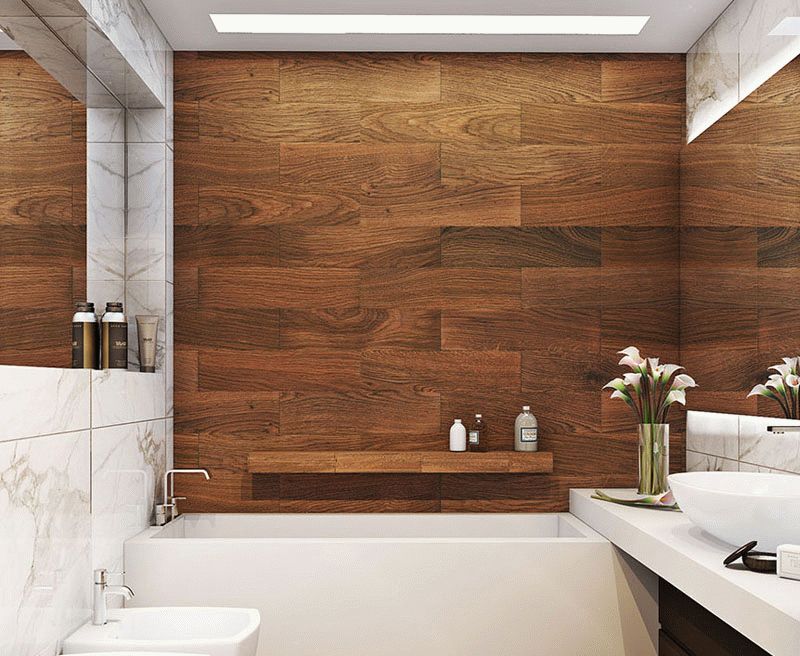 Finishing the walls with a bathroom linoleum is extremely rare, but it is an excellent option for those who want to stand out from stereotypes
Finishing the walls with a bathroom linoleum is extremely rare, but it is an excellent option for those who want to stand out from stereotypes Linoleum for wall finishing in the bathroom is a useful combination of great originality, low cost and good durability.
In the process of repair, finishing materials are often selected based on personal preferences and stereotypes: paint on the walls - associated with public institutions, and mosaic and textile wallpaper - with a luxurious palace. However, when it comes to the bathroom, it is necessary to choose, first of all, practical finishing materials. There are certain requirements that must be satisfied by the finish of the bathroom: the ability to withstand high humidity, temperature changes, resistance to the formation of fungal colonies, good strength, ease of care and the ability to apply abrasive cleaners.
What is the finish of the bathroom
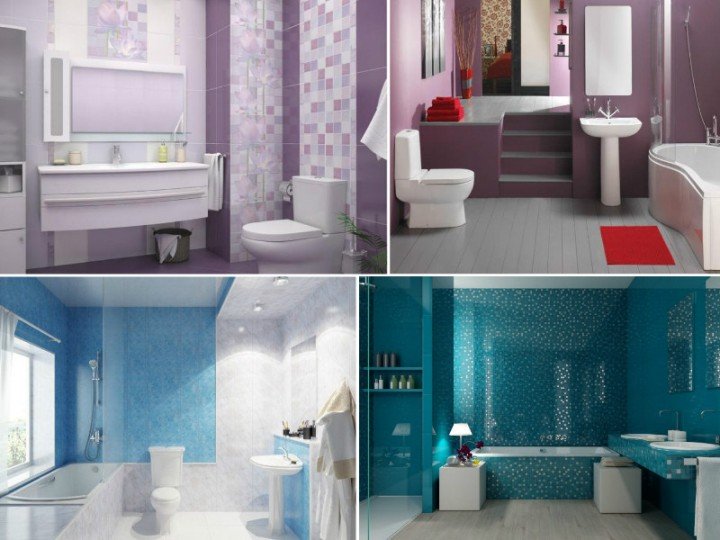
Types of finishing materials suitable for decoration of bathroom walls:
1. Ceramic tiles
The most common choice for owners of average urban apartments. This "eternal trend" is equally well suited for both classical and modern bathroom interiors.
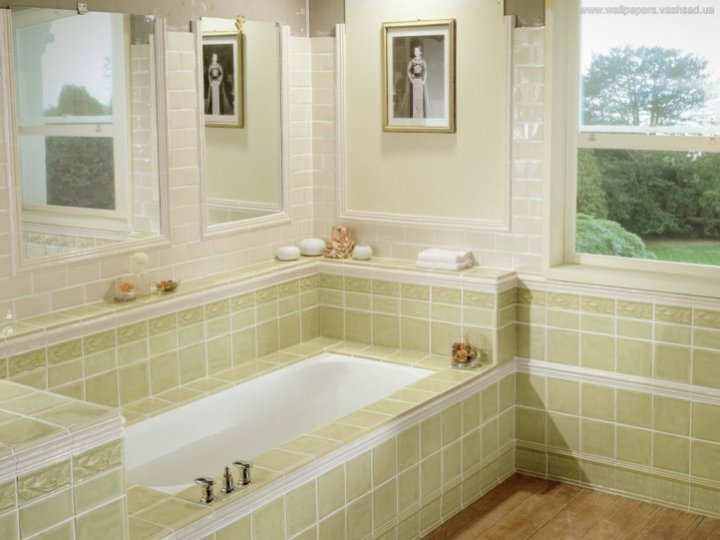
Advantages of ceramic tiles:
- a wide range of products and, as a result, a variety of shades, textures and patterns;
- the glossy surface makes the room more light and spacious;
- such a finishing material is easy to clean and clean;
- long service life;
- a wide price range, which allows you to choose a tile for every taste and purse;
- you can easily make a partial repair, replace the cracked tile or glue the fallen out;
- you can use a grout for grouting.
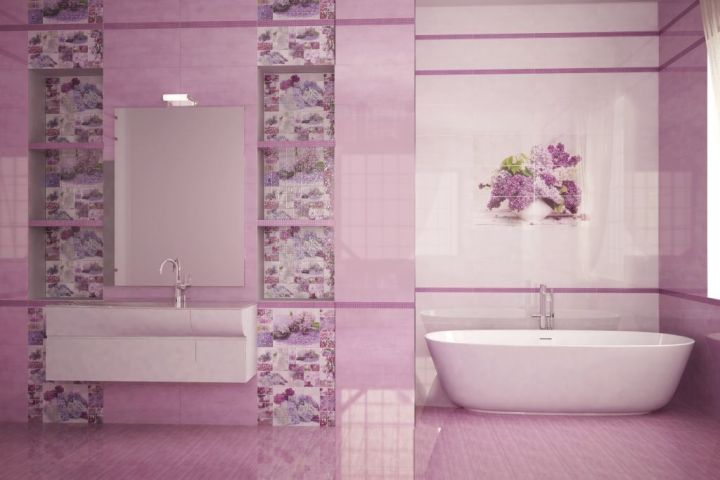


Disadvantages:
- the cost of laying is quite high and depends not only on the area of the bathroom, but also on the size of the tiles. The smaller the product, the more expensive the tiled walls will cost you;
- with careless handling the tile is easily broken with a heavy object;
- it is so common in the interiors of our bathrooms that sometimes you want something truly original and unusual.
2. Agglomerates
We can say that this is a thin slab of artificial material, reminiscent of ceramic, which got rid of almost all the disadvantages of ceramics, but acquired several other disadvantages inherent in synthetic materials.
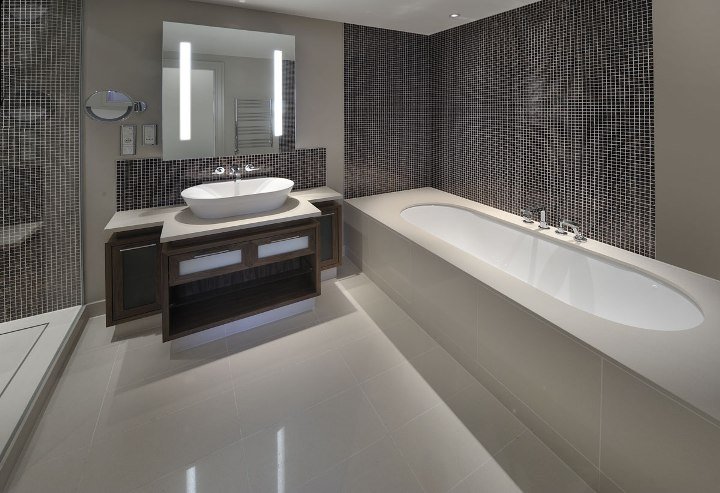
Benefits:
- this finishing material completely imitates ceramic tiles, but is more durable, resistant to abrasive cleaning agents and easier to lay;
- also has a glossy surface;
- a wide range of products of different colors and textures.

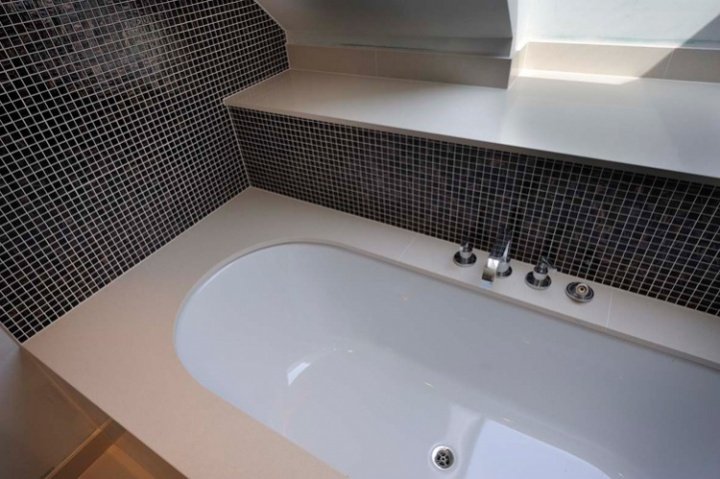
Disadvantages:
- expensive finishing material;
- is not a natural, environmentally friendly material.
3. Panels made of polyvinylchloride (PVC)
The most affordable solution, suitable for those who believe that the advantages of plastic panels are more than minuses.
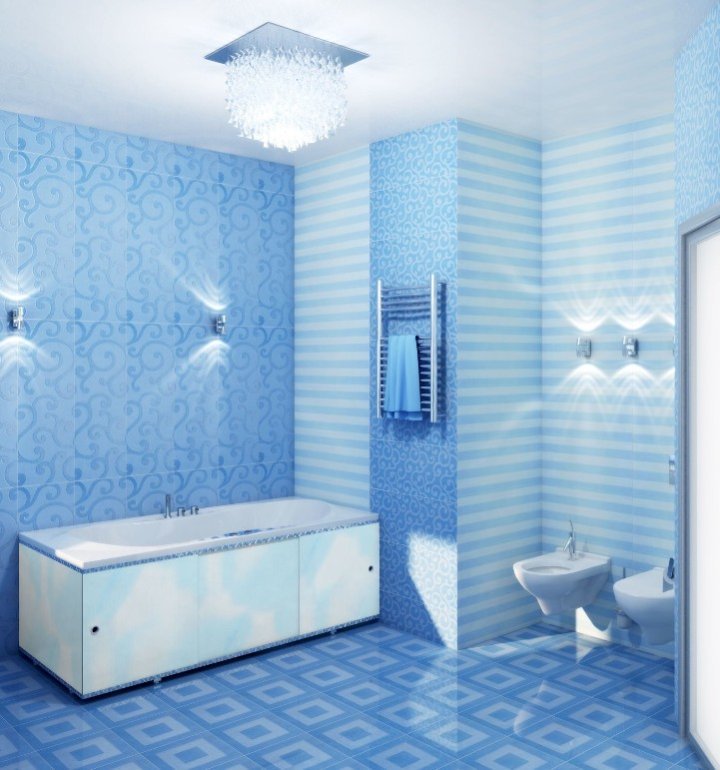
Benefits:
- you can choose imitations of wooden or stone surfaces;
- low price of the material;
- durable plastic can withstand the temperature and humidity changes;
- it is very easy and convenient to wash, however, it is better to use mild detergents;
- PVC panels are mounted on the crate, pre-installed on the wall, so no leveling of the surfaces is required;
- plastic panels - a reasonable choice for new buildings, because such material is not sensitive to the possible "sagging" of the house for the next few years;
- the design is similar to suspended ceilings and therefore allows you to hide behind the panels thin water pipes and integrate spotlights.
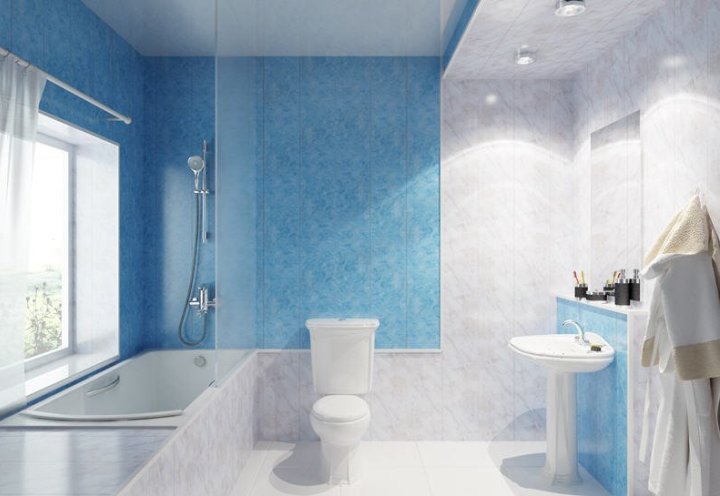
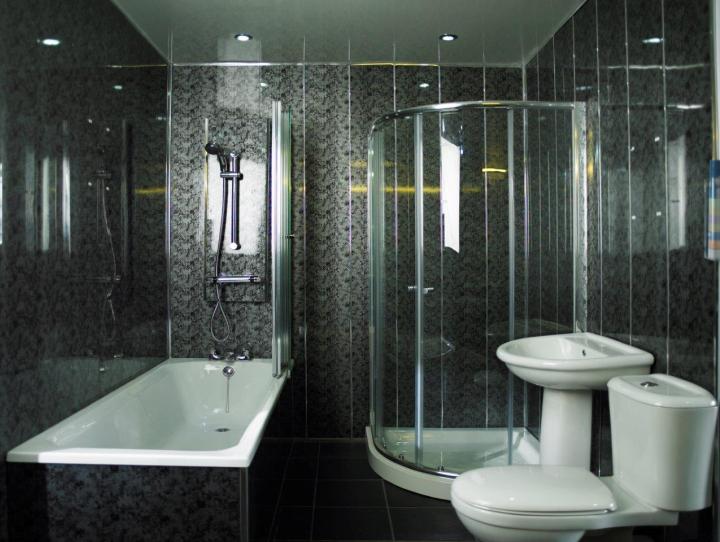

Disadvantages:
- the use of a billet and panels reduces the area of the bathroom;
- plastic easily scratches;
- artificial material.
4. Gypsum plasterboard sheet (GCR)
This refers to a special moisture-resistant plasterboard, in order not to confuse it with a conventional GCR, it is produced in mint green color.
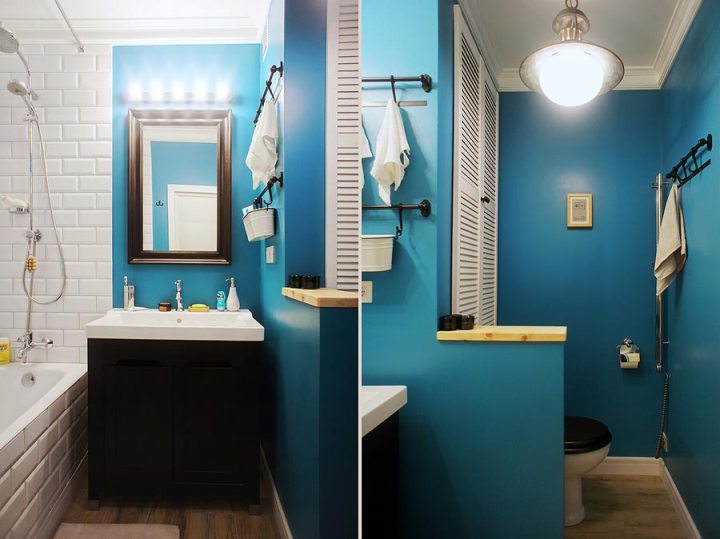
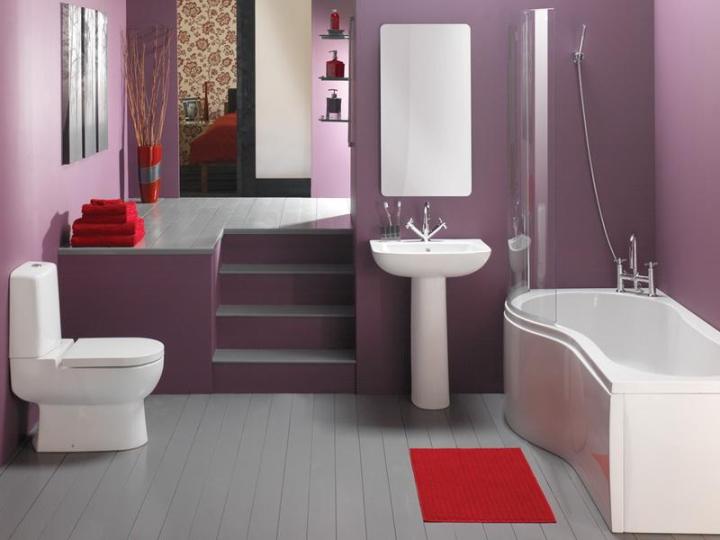
Benefits:
- inexpensive;
- just mounted due to its light weight;
- good sound and heat insulation properties.
Disadvantages:
- after plating the walls of the GKL, the useful volume of the bathroom will decrease;
- additional components are required, incl. profiles;
- additional decorative finish (for example, color).
5. Wallpapers for the bathroom
For the bathroom only materials marked with the "three waves" icon (full waterproof) are suitable. Walls of the bathroom can be pasted with superwashing vinyl wallpaper, as well as glass walls and special moisture-resistant wallpaper. Steklooboi after gluing is usually painted, which gives them additional watertightness.
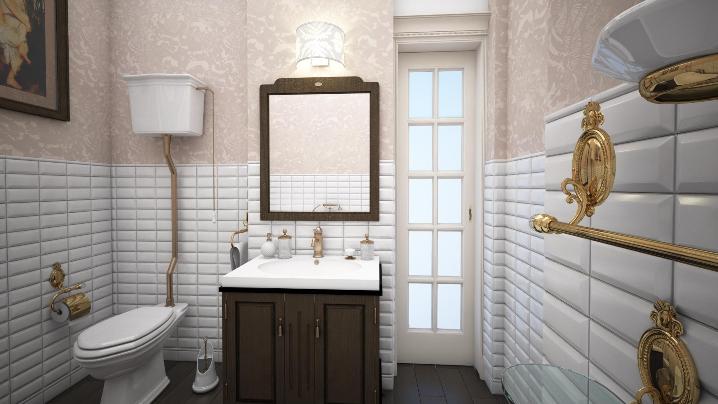
Benefits:
- stylish and unusual solution, well suited for classical interior;
- wide range of prices, shades and patterns, incl. imitating natural finishing materials (marble, wild stone, brick);
- glue wallpapers can do everything.
Disadvantages:
- wallpaper - a fragile material that can easily be damaged by careless handling;
- vinyl does not pass air, therefore, in order to avoid the appearance of mold under the wallpaper, it is necessary to take care of quality forced ventilation;
- need a special expensive moisture-resistant glue, which includes antifungal agents.
6. Self-adhesive film
This coating, which on one side looks like a finishing material (imitating a tree, wallpaper, stone), and on the other has an adhesive base.
Benefits:
- very quickly and easily glued to a smooth smooth surface;
- various colors;
- low price.
Disadvantages:
- solution for emergency cosmetic repairs, t. has a fairly "cheap" look;
- the low strength of the coating leads to the formation of air bubbles under the film and to its gradual peeling.
7. Paint
Smooth and smooth walls can be painted, having a very practical interior. Only for finishing a moisture-resistant paint is needed, because the painted surface should be easy to wash and repel dirt. Therefore, it is better to use latex paint.
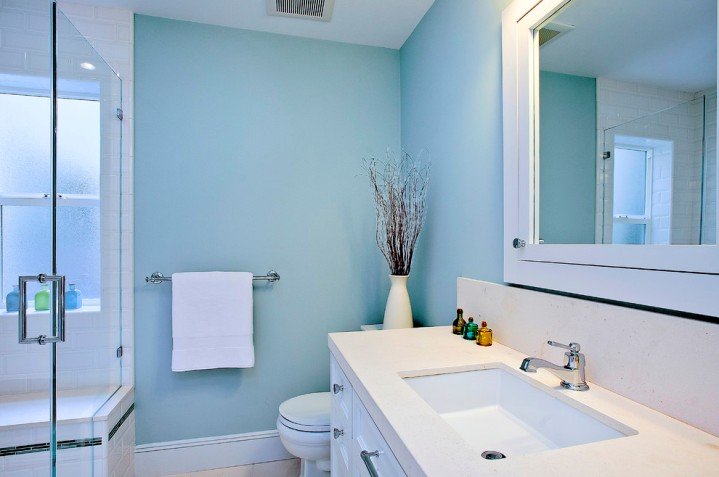
Benefits:
- painting the walls is much easier than laying the tile;
- low cost of wall finishing when using paint;
- you can by creating a unique bathroom interior.
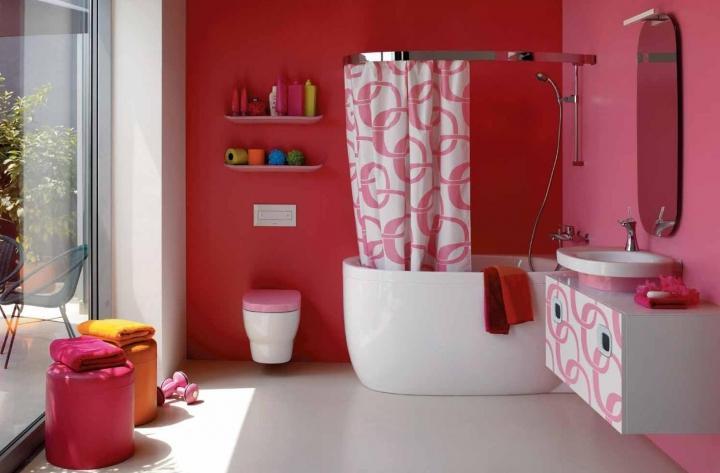
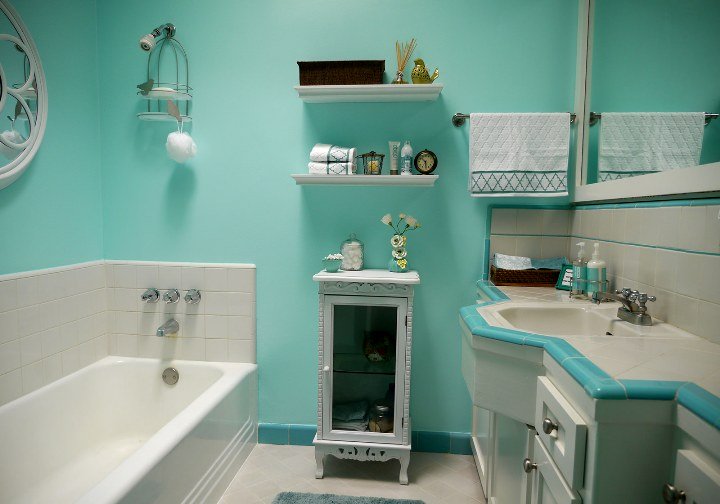
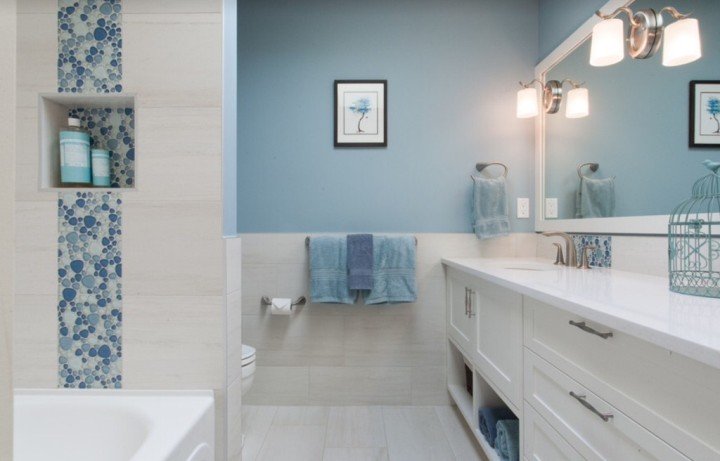
Disadvantages:
- a stereotype that painted walls are found only in sanatoria and polyclinics;
- before painting, the surface must be leveled;
- requires regular care and the use of soft cleaners.
There are also non-standard solutions. Occasionally, the bathroom is decorated with natural marble, colorful glass or mirror tiles, hand-painted and laid out mosaic paintings, wood panels treated with special impregnations to improve water resistance and antifungal agents. It remains only to decide which of the above finishes is suitable for your bathroom.
Today, many are ready to transform the surface of walls and ceiling in each of the rooms a country house or a city apartment. In this case, you can use a large number of materials and various kinds of solutions. Allowing themselves to create new grounds and variations in changing the appearance of each of the selected premises. But here some methods can not give such possibility, as creation of additional niches or an ideal alignment, without loss of the demanded area in a premise. That is why it is worth paying attention to the current photos of repairing the toilet with plastic panels, allowing to transform completely the surface of walls and ceiling. Such opportunities can be applied, as in a country house, and in a city apartment. Creating an eccentricity of the entire design of the finishes.
At present, the mosaic for the bathroom is widely spread and manufactured by industrial enterprises in large volumes. It has a wide variety of shapes and colors, and can also be made from a variety of materials. Thanks to this, it became possible to implement all design solutions and fantasy. The bathroom with tiles mosaic almost always looks very aesthetically and modern.
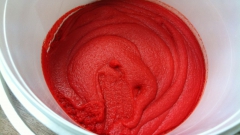
Grout for tiles in the bathroom - a guarantee of durability and durability of ceramic floor and wall coverings. Depending on the composition, it can be cement and epoxy. Pros and cons of both kinds. How to choose the best option for yourself, without resorting to inexpedient costs?

Make your bathroom original with colored tiles. It is sold in a wide range in building supermarkets. Take advantage of our advice and get harmoniously combined, high-quality tiles on the floor, for walls. Read more about everything in the article.
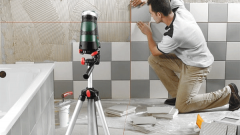
Tile is one of the most popular materials for finishing the bathroom. It is durable, wear-resistant, durable and resistant to moisture. To properly put the tiles in the bathroom, you need to consider a number of features of this process. In the absence of experience and necessary skills, it is better to entrust this matter to the master.
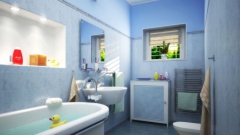
Decorating the bathroom with plastic panels is now very popular, because it's a simple and relatively inexpensive way to design your bathroom. Quality modern plastic is pretty practical, so you can safely use it when finishing the bathroom, after consulting with specialists.

In this article, you have the opportunity to learn about wall panels PVC, which are excellent for the bathroom, can create a cozy environment and are a good substitute for other materials, for example, tiles or marble. Also you will learn about the approximate costs for this material and about the various variations of panels offered by all kinds of shops.

Tile for the bathroom is a kind of finishing material, which remains unchallenged. This is helped by important features that can be considered for optimal choice.
Than to finish walls in a bathroom: all possible options
The most capricious and problematic room in terms of repair can be called a bathroom. In order to qualitatively repair the walls in the bathroom, serious preparation is required: carrying out rough work and choosing the finishing material.
The choice of material for wall finishing in the bathroom should be approached particularly seriously, since the room will often be filled with moist air and subjected to a temperature drop. The finishing material should not only not be deformed and not spoil under such influence, but also to preserve its appearance. Hence, and be easy to care for. Also, the finishing material must be combined with the general bathroom interior design.

Ceramic tile
Decorating the walls in the bathroom with ceramic tiles will always be classic. Tiles have certain qualities that explain its popularity:
- even at the highest humidity of the room, tiled walls in the bathroom can last several decades;
- the tile is easy to clean;
- a variety of decorative solutions, tiles on the walls in the bathroom can be used in different colors, sizes and textures.
Cladding the walls of the bathroom can be done in several ways:
- tiles cover the walls completely;
- the tile is glued to half;
- tile only some areas of the room.
The lining of small bathroom walls can be carried out first and second way. For large - all three are allowed. With tiles on the walls should be combined and bathroom floor.
Laying tiles can be in many ways:
- uniform placement of the seam to the seam along the vertical and horizontal lines;
- laying diagonally;
- stacking in the form of a chessboard;
- modular way of laying (tiles of different sizes);
- decoration of the walls of the bathroom with tiles in the form of an ornament (tiles of different colors or tiles with a pattern applied);
- patchwork (tiles with a pattern not united by a common theme).
Ceramic tiles take the origins of their name in ancient Greece. The word "keramos" translates as "burn". This name is explained by the technique of obtaining this finishing material.
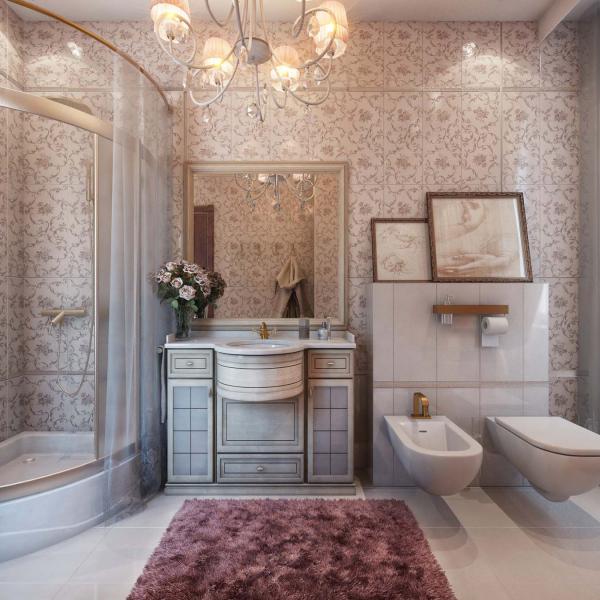
Decorating with mosaic
Than to finish a bath except for a tile, but the same quality? With the help of a mosaic, you can achieve this effect, but at the same time create a unique design for your bathroom.
In order to keep the mosaic covering of walls in the bathroom firmly, it is necessary to choose the right glue for it. It must be moisture resistant, viscous and have high adhesion properties. Glue for mosaic should be taken in white. This will allow transparent parts of the mosaic to look most spectacular.
Than to wall in the bathroom of any surface? The mosaic will do. This material can be used to decorate walls:
- concrete;
- metal;
- wooden;
- plastered.
![]()
Finishing with agglomerate
Comes to fashion modern decoration walls of the bathroom agglomerate. This is a new finishing material that looks like ceramic tiles. Finishing agglomerate significantly benefits in installation. To fix it in place is much easier than to trim the walls of the bathroom with tiles.
Its main advantage is considered flexibility when heated, which allows you to finish not only perfectly flat surfaces. Wall covering in the bathroom with agglomerate is recommended in new buildings. Its plasticity will prevent the appearance of cracks on the walls.
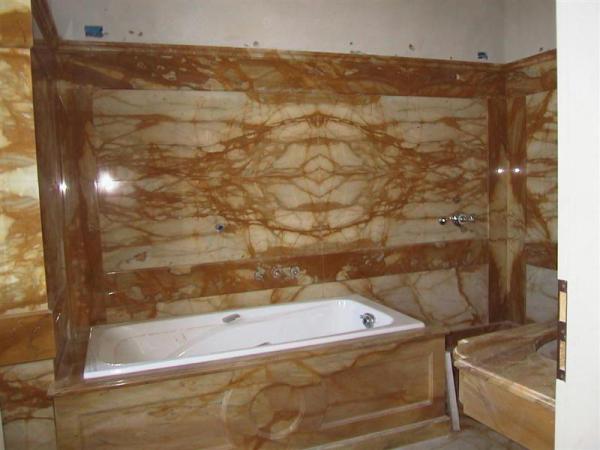
Decorating with plastic panels
Plastic is a modern finishing material with many advantages. It is resistant to moisture and steam. This finishing material for the walls of the bathroom is quite strong. Also, the plastic is environmentally safe, very simple to install, has a low cost. And the greatest advantage - low cost.
To design the walls in the bathroom created a pleasant atmosphere, it is worth paying attention to several factors when buying. Plastic panels should not be deformed and should have the same shade.
Installation of plastic panels on the walls can be done in two ways. Before closing the walls in the bathroom with plastic, the walls themselves are fastened to the crate. In the second case, the panels are fixed with glue, for example with "liquid nails".
The first method of fixing is not suitable for a small room, since it will additionally take some space. For the second method, it is necessary to repair the walls of the bathroom by aligning them.
Thus, plastic finishing is much more advantageous in many respects. Many people prefer to use this material than to make walls in the bathroom with tiles or mosaic. Plastic is also used for ceiling finishes.

Self-adhesive film finishing
This is the cheapest bathroom finish. The film is a thin layer of PVC on a sticky paper base. The upper layer of the film is covered with a protective material, protecting it from dust, moisture and damage.
The options for finishing the walls of the bathroom with a film have their advantages:
- low cost;
- ease of use;
- ease of maintenance;
- a variety of suggested colors and patterns;
- the ability to glue any surface.
Before coating the walls of the bathroom with a film, they should be degreased. If the surface of the walls is porous, then several layers of primer must be applied to it.
This version of the finish can be called cosmetic. It is much easier to make this work than to cover the walls in the bathroom, for example, with wallpaper. To ensure that the film is better adhered and kept on the surface, you need to use a primer based on acrylic.

Wallpaper decoration
Another cheap option for finishing the bathroom is the wallpaper. You can use a liquid wallpaper, but pasting the walls in the bathroom is recommended with vinyl wallpaper. Moisture is not terrible for them.
You do not need to look for materials that are cheaper than to cover the walls in the bathroom. Since the temperature drops from inexpensive wallpaper can produce harmful substances.
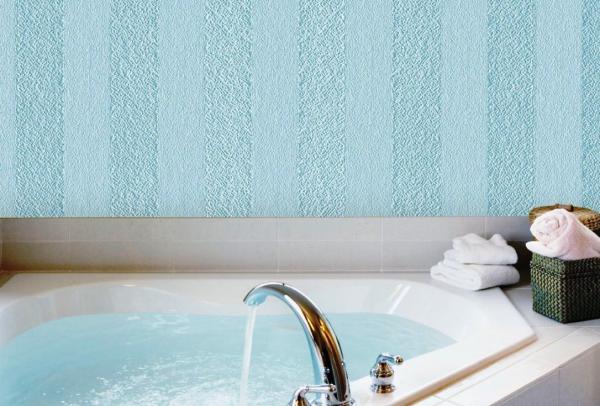
Paint finish
Today's colors are much better and not as toxic as before, which allows them to be used as a modern finishing material. In addition, it is quite cheap finishing of the bathroom.
Choosing the paint for the bathroom, you should consider its moisture resistance. The following paints and enamels have this quality:
- alkyd;
- latex;
- acrylic;
- oil.
The latter are used in decoration less and less.
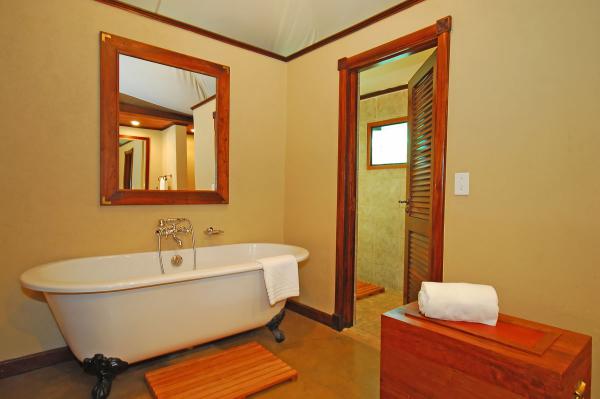
Materials for walls in the bathroom should be selected correctly. Whatever the moisture resistance does not have paint, in the bathroom and sink area you need to use something else, as the paint will quickly deteriorate from constant moisture.
Paint color should be light shades. For example, the blue walls in the bathroom will make a small room even less visually.
Before applying the paint you need to prepare the walls:
- remove the remnants of previous materials;
- plaster the surface;
- the surface must be treated with a primer than making the walls in the bathroom protected from bacteria.
Variants of painting the walls in the bathroom include applying the paint in several layers. Before applying a subsequent coat of paint, you need to allow time to dry up the previous one.
When finishing the bathroom, great attention should be paid to the plumbing. Read about this in this article . A special kind of room is able to give correctly decorated lighting, in detail.
Other solutions
There are other unusual materials for the walls of the bathroom:
- Drywall. Convenient for installation, easy enough and low cost.
- Marble. Durable, natural and breathable material. This is quite expensive material.
- Mirror tiles. This finishing material visually expands the space. But the material is brittle and requires constant care.
- Wood. Methods of finishing the walls in the bathroom provide for the treatment of the finishing material with an antiseptic and water repellent.
- Linoleum. Material is made only to order. It is very durable, practical and elastic. Its cost is very high.
- Photo walls in the bathroom will look unusual. For the decoration of the walls you can use ordinary or 3d washable wall-papers. There is an opportunity to make and individual order on your sample photo. In this case, photo 3d wall in the bathroom with your favorite scenery will help to relax in warm water.
Also common and combined walls in the bathroom. In this case, not only different types of finishing one material, but also different materials are used.

In a large room, you can build a wall in the bathroom or a small partition, where it will somewhat delineate the space. Material for it should be chosen light and moisture resistant. The partition should not greatly obscure the room, but the transparent wall in the bathroom will rather be inappropriate.
What walls in a bathroom to make - to solve everyone independently. The main thing is that they serve as long as possible and keep their freshness.
The video is more detailed on the decoration of the walls of the bathroom with plastic:
